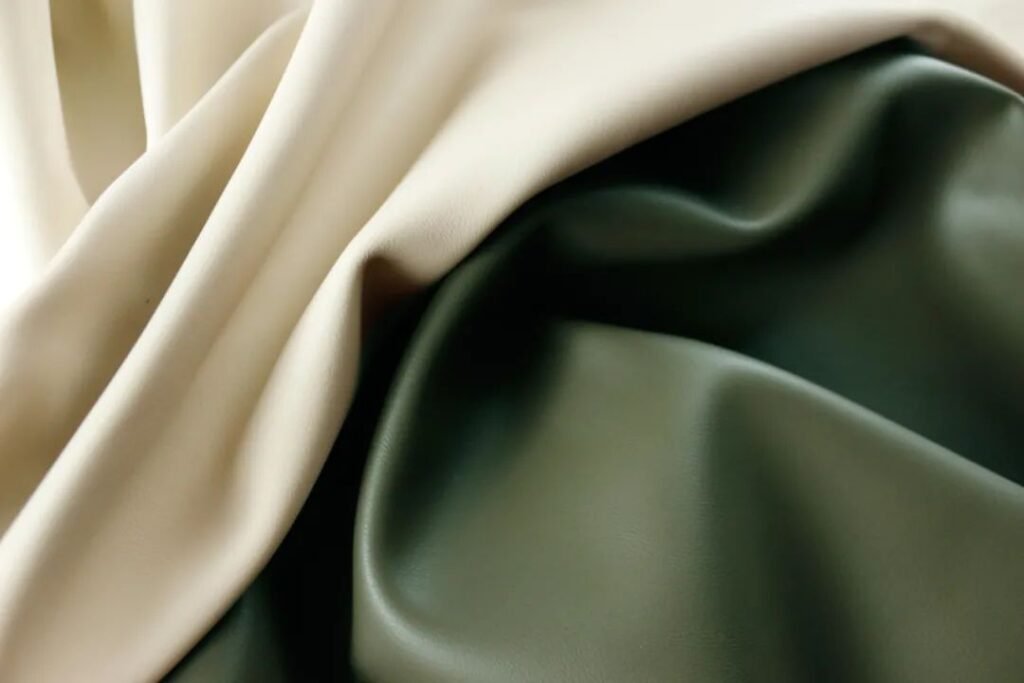As a seasoned professional in the leather industry, I’ve witnessed the evolution of materials that challenge traditional leather. Silicone leather stands out for its unique properties and composition.
This post delves into what silicone leather is, how it compares to other materials like PU and PVC leather, and its specific makeup.
We’ll explore its diverse applications across various industries and discuss why it’s becoming a preferred choice for eco-conscious consumers. Join me in uncovering the fascinating world of silicone leather.

What is Silicone Leather Made Of?
Silicone leather is a synthetic material made from silicone, a polymer known for its durability and eco-friendliness. Unlike traditional leather or other synthetic alternatives like PU and PVC leather, silicone leather is free from animal products and certain harmful chemicals.
It offers unique properties such as high resistance to wear and tear, water, and environmental factors. When compared to PU and PVC leathers, silicone leather stands out for its safety standards and lower environmental impact, making it a sustainable choice in various industries.
Composition and Production
Silicone leather is produced using a base of silicone, a flexible and durable polymer. This base is then layered onto a fabric backing, creating a material that mimics the feel and appearance of traditional leather.
The production process is more environmentally friendly than that of PU and PVC leathers, as it typically involves fewer toxic chemicals and emits less pollution. This makes silicone leather a more sustainable choice, aligning with increasing environmental awareness and consumer demand for eco-friendly products.
Properties of Silicone Leather
Silicone leather is distinguished by its exceptional durability, making it more resistant to wear, tear, and environmental factors compared to traditional leathers. It possesses a unique texture that can closely imitate genuine leather, providing a similar tactile experience.
Additionally, silicone leather maintains its appearance over time, resisting fading and cracking, which is often a challenge with other synthetic leathers. These properties make it a versatile and increasingly popular choice for various applications, from fashion to upholstery.

Silicone Leather in Various Industries
Silicone leather’s versatility sees it being embraced across multiple industries. In the fashion sector, it’s valued for its durability and aesthetic appeal, offering a sustainable alternative to traditional leather in clothing and accessories.
The automotive industry appreciates its resistance to wear and environmental conditions, making it ideal for vehicle interiors. Furthermore, its durability and ease of maintenance make it a favored choice in furniture manufacturing, providing a long-lasting, stylish option for both indoor and outdoor furnishings.
Benefits of Silicone Leather
The benefits of silicone leather are numerous, making it a standout material in the world of synthetics. Its eco-friendliness is a key advantage, as it’s more sustainable and less harmful to the environment compared to traditional and other synthetic leathers.
Additionally, silicone leather is low maintenance, requiring minimal care to maintain its appearance. It’s also highly resistant to stains and water, making it practical for daily use in various applications, from fashion items to furniture.
Caring for Silicone Leather
Caring for silicone leather is relatively simple, ensuring its longevity and appearance. Regular cleaning with a soft, damp cloth is usually sufficient to remove dirt and maintain its look. For tougher stains, a mild soap solution can be used, followed by a thorough wipe with a clean, damp cloth.
It’s important to avoid harsh chemicals and abrasive cleaners, as they can damage the material. Additionally, silicone leather doesn’t require special conditioning, making it a practical and low-maintenance option.
Future Trends in Silicone Leather
The future of silicone leather looks promising, with potential innovations focusing on enhancing its eco-friendliness and functionality. As demand for sustainable materials grows, silicone leather is expected to evolve with advancements in eco-friendly production methods.
These innovations could lead to even more durable, versatile, and environmentally sustainable versions of silicone leather, expanding its applications in various industries. The market trend suggests a growing preference for materials that balance practicality with environmental responsibility.
Conclusion
Silicone leather represents a significant step forward in sustainable material choices. With its eco-friendly composition, ease of maintenance, and wide range of applications, it offers a viable alternative to traditional and other synthetic leathers. Its unique properties, including durability, water resistance, and aesthetic appeal, make it suitable for various industries.
As we look towards the future, silicone leather continues to evolve, promising even greater sustainability and versatility. This makes it an increasingly popular choice for those seeking eco-conscious material options.








